





 |
 |
 |
 |
 |
 |
| Michael Ng | profile | all galleries >> Photo Gear & Reviews >> Nikon 300mm f/4 AF-S | tree view | thumbnails | slideshow |
| The Nikon 300mm F4 ED-IF AF-S was introduced by Nikon Japan in August of 2000. It was set to replace the legendary 300mm f/4 AF, which experiencing a drop in popularity due to Nikon’s move to Silent Wave AF. When it was introduced, there was some air of disappointment that it did not feature Vibration Reduction (VR) like the 80-400mm which was released in January of that year. However the introduction of AF-S, ED-elements and a host of other perks made this lens an upgrade from its predecessor. |
 Nikon 300mm f/4 AFS mounted on a F100 w/ MB15.
Nikon 300mm f/4 AFS mounted on a F100 w/ MB15. |
Lens Construction: 10 elements in 6 groups (2 ED) Picture Angle: 8 degrees 10 minutes (35mm format), 5 degrees 20 minutes (Nikon DX format) Minimum Focus Distance: 4.8 ft. Maximum Reproduction Ratio (Macro Setting: 1:3.7 Attachment/ Filter Size: 77mm Dimensions (diameter x length - in.): 3.5 x 8.8 Weight (oz.): 50.8 oz. Nikon Lens Hood: Built-In Case(s): Ballistic Nylon -CL-M2 Included Accessories: CL-M2 case, front cover, rear cap New Price: USD$1104.95 Used Price: USD$750-800 (mint) |
 Beautiful black and gold, with Nikon’s signature crinkle finish. 
Case of the missing rear element. Aperture is exposed. |
GETTING ACQUAINTED: What’s in the Box: The lens comes with the same nylon carrying case (CL-M2) as the 70-200mm f/2.8G AFS VR. My case stays in storage and never sees any use. The lens also comes with a removable tripod collar (more on this later) and the standard Nikon front and back caps. Of course, the manual is included. Cosmetics: The 300mm f4 AFS came with the nice crinkle finish found on all of Nikon’s newer high end lenses. This texture gives it a really good feel and may, although negligibly so, improve one’s grip on the lens. Nikon calls this a “simulated leather finish”. The diameter of the lens barrel is noticeably larger than the 300mm f/4 AF. It looks a lot less like a lead pipe or a piece of plumbing too. As nice as this may sound, this fact also means taking up more space in your camera bag. Where’s the Rear Lens Element? I was shocked when I removed the rear lens cap and peered into the lens. There was no rear element to be found! The first thing you see when peering behind the lens is the aperture. After the aperture is the last lens element. Interesting design there, which worries me about damaging the delicate aperture blades. However the aperture is deeply recessed beyond the reach of stray fingers so it should be pretty safe. Still, I would think twice about trying to clean the rear lens element should the need arise. |
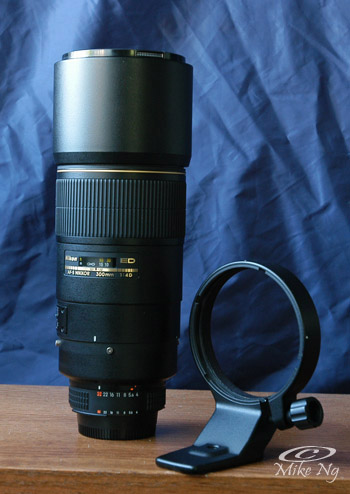
300mm f4 AFS with the removable stock tripod collar 
MF/AF switch and Focus Limiter. |
FEATURES: Hood: Just like its older brother, the 300mm AFS comes with a built-in hood. The hood snaps into place when in its retracted position. When extended, the hood is secured by twisting it until it tightens to the lens front end. Tripod Collar: Having used the 70-200mm f/2.8 AFS VR and its wonderfully crafted collar, I could perfectly understand the countless gripes 300mm f4 AFS owners had about the one on their lens. I wouldn’t label it as total crap, nor would I say that it’s great either. Stability issues apart, which I will leave to the experts to measurebate over, the rotating action of the tripod collar isn’t smooth by any means. It does not feel damped like the 70-200mm. Instead it feels like the coarseness of metal rolling on metal. Kirk makes a tripod collar replacement called the NC-300 which will set you back a good $150 excluding shipping. I read that it’s an excellent substitute. But considering the fact that I rarely shoot outdoors with a tripod I don’t think I can justify splurging on a replacement. 77mm Filters! “No more drop-in filters!” exclaim those who have stepped up from the 300mm f4 AF. I think it’s wonderful indeed that the AFS version is compatible with the standard filter diameter for most pro-grade lenses. But other than maybe a protective UV filter from time to time, I don’t see myself using filters on this lens. Maybe a polarizer, but then again that would be really rare. Thumb Switches: The 300mm f4 AFS comes with two switches conveniently placed on the left hand side of the lens where ones thumb would normally be. i) M/A and M switch: This switch turns on and off the Silent Wave motor. Helps you save battery juice too. ii) Focus limiter switch This enables you to limit your AF range between infinity to 3m. This improves AF speed and reduces hunting too. Pseudo Macro: One of the biggest selling points of this lens is its close focusing capability. This lens focuses down to 1.45m giving a reproduction ratio of 1:3.7 which is about a quarter life-size. Doesn’t sound like much but when you’re shooting with a D-SLR, this value increases (think crop factor and megapixels). Oh, and with the 77mm filter thread, you can slap on a Canon 500D achromatic close-up lens for an even larger magnification! According to Ricardo Polini the ratio should be about 1:1.1 on a Nikon D100. |
|
FIELD TEST: AF on this lens is fast. Not as fast as the 70-200mm f/2.8G, probably due to its smaller maximum aperture, but adequately quick and silent. The AF motor does exhibit some slight “chattering” once in a while. The manual override AF feature of this AF-S lens is a great plus especially when you want to fine-tune where you want your focus to be on. On occasion, the AF sensor on your camera can be tricked, but with a slight twist of the AF ring, the focus can be adjusted without having to flip the MF switch. Unfortunately, this lens doesn’t have AF-lock buttons on its barrel like its more expensive f/2.8 relatives.. Images produced by this lens are very sharp and contrasty. I’m very satisfied with the pictures produced taken by this lens, which are very well saturated and pop-out at you. The results are on par and often exceed what I’m used to getting on the 70-200mm f/2.8G. Other reviews suggest that it is almost as good as its 300mm f/2.8 AFS brothers. This lens is also extremely versatile, being handy for real tightly cropped portraits down to tack sharp macros. Many associate lenses this range for sports, but I’ve found that given its features, so much more can be achieved. Teleconverters: This lens is only compatible with teleconverters that are compatible with Nikon AF-S lenses like the TC20E, TC14E (I & II) and the TC17E II. However, due to the limitations to the focusing and maximum aperture, it is recommended that you use only the TC14E (I & II) and the TC17E II teleconverters. For each teleconverter your settings change as follows: i)TC 14EII Focal Length – 420mm Maximum Aperture: f/5.6 ii)TC 17EII: Focal Length - 510mm Maximum Aperture - f/6.8 I have only used this lens with the TC17E II. AF speed slows considerably, but the image quality is still top notch. Users of the TC14E have reported that there is almost no loss of image quality when the 300mm f/4 AFS is coupled with the TC14E. *The TC14E and the TC14E II are both optically similar. The only difference is the finishing in which the TC14E II has Nikon’s “Simulated Leather” finish to match the newer lenses (namely the 70-200mm f/2.8G) better. ©Michael Ng 2005 |

Lens as a portrait lens with great subject isolation. 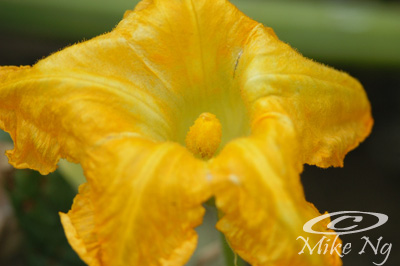
As a macro lens (not full ratio). |
If you enjoyed reading this review and would like to support this site, please make a purchase through my recommended retailers via the links below. It costs you nothing extra but allows me to keep these reviews available to the public for free. Thanks! |
|
Or make a contribution: |
 Focus Window |
 Switches |
 Aperture |
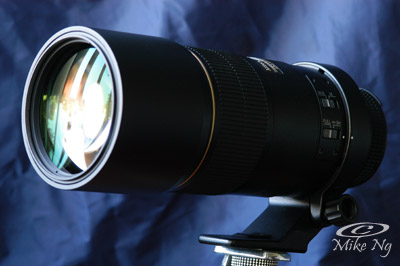 Side profile |
 F100a |
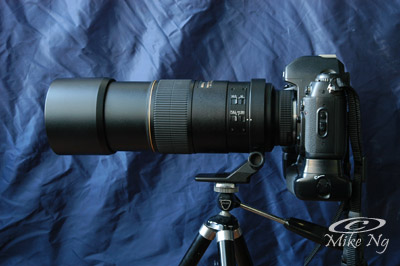 F100b |
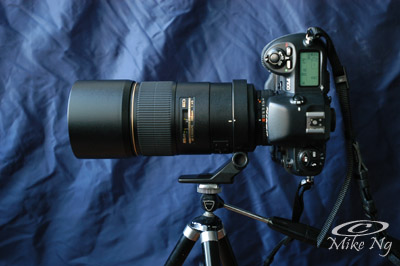 F100c |
 Tripod Collar Removed |
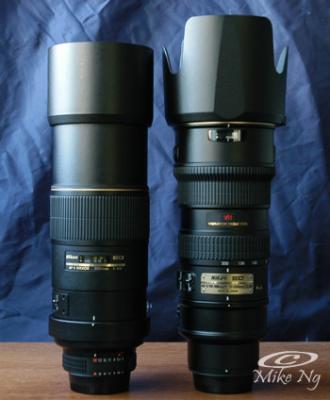 300mm vs. 70-200mm w/ Hoods |
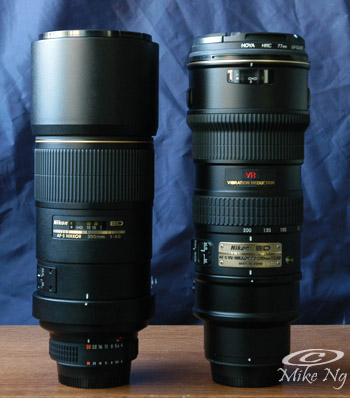 300mm vs. 70-200mm w/o Hoods |
 Portrait |
 Pulling Power |
 Macro |
| comment | share |
| Sermet | 29-Nov-2012 20:23 | |
| Ken Wilson | 18-Sep-2012 14:50 | |
| Christofer | 27-May-2011 17:35 | |
| Lorne | 14-Nov-2010 20:46 | |
| Jampa | 11-Oct-2010 14:51 | |
| khusro | 21-Apr-2010 10:29 | |
| Guest | 05-Apr-2010 11:57 | |
| John Williams | 04-Apr-2010 13:37 | |
| John Williams | 04-Apr-2010 13:37 | |
| Guest | 19-Mar-2010 22:39 | |
| Ron | 10-Mar-2010 04:25 | |
| Richard | 14-Feb-2010 23:17 | |
| Wes | 28-Dec-2008 23:57 | |
| Guest | 31-Oct-2008 20:40 | |
| Paul Hogan | 06-May-2008 02:56 | |
| Gary | 17-Jan-2008 08:36 | |
| Pedro Nunes | 06-Jan-2008 15:57 | |
| papa85 | 31-Dec-2007 15:09 | |
| rifat oktem | 03-Nov-2007 17:39 | |
| Rifat Oktem | 03-Nov-2007 17:37 | |
| Guest | 02-Nov-2007 01:55 | |
| Alex | 31-Aug-2007 00:00 | |
| Adjacir Cidrão | 11-Jul-2007 16:45 | |
| Yi Feng | 14-Jan-2007 22:32 | |
| Shan Rawlins | 14-Aug-2006 11:27 | |
| Guest | 23-Jun-2006 18:37 | |
| Guest | 14-Jun-2006 01:02 | |